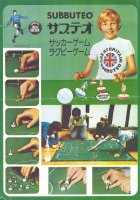
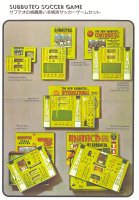
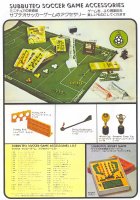
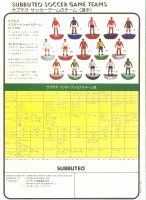
| Peter Upton's |
|
Subbuteo Tribute Website. |
|
Catalogues and Price Lists |
|
Subbuteo's far outposts - Japan and New Zealand. |
As explained on my European Catalogues page, Waddingtons were keen to open potential market for Subbuteo wherever football was played, which was (and is) basically everywhere! Their strategy was to find partners in other territories, usually established toy/game companies, who could provide marketing and distribution for the game.
The following companies are known to have distributed Subbuteo outside of Europe.
The companies who don't have their own page (yet) feature on either on the International box sets page or the International Team Production page - or both.
Japan - United Industrials Ltd.




Subbuteo reached Japanese shores in the mid 1970s, in the era of the Munich Edition. I wonder how many of those made it to Japan? The distributor was United Industrial Ltd.
The catalogue illustrated is A4 in size, and similar to those issued by Delacoste in the same period. Indeed, the page showing all the sets is identical to a Delacoste catalogue. However, the accessories picture comes, not from the French catalogue, but from the 1974/75 English poster. This means that C136, the Subbuteo Sound is illustrated. However, this is one of only two accessories on the accompanying price list that does not have a price in yen (C129 is the other). So sadly, perhaps the Wadhurst school band can't lay claim to being "big in Japan".
It is also worth noting that the Subbuteo rugby edition was also made available in this rugby playing nation. The red and white hoops of R13 would be perfect for Japan's national team, but although a common sight in early rugby sets, I think the sets were mainly red and blue teams by the mid 1970s.
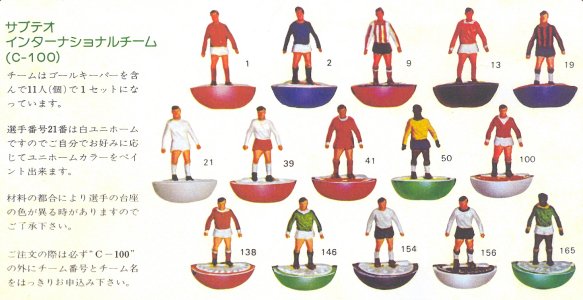
Whilst the whole 1970s accessory range seems to have been made available to the Japanese, the team range was sadly truncated to a meagre fifteen top teams. Although the Japanese national league started in the mid-1960s, this was long before the high profile J-League. So Japanese punters had to make do with a few top club and international sides from around the world. It is interesting to note that the infamous green Santos made the cut.
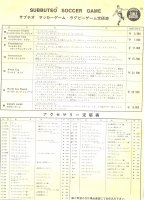

This is the accompanying Japanese price list. The Munich set was a "reasonable" 25,500 yen. The Display edition was 3900 yen, and a team cost 1000 yen.
1980s Japanese Catalogue.
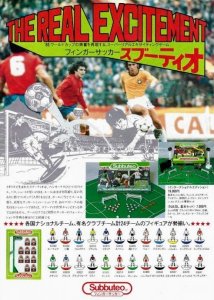
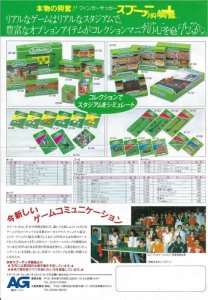
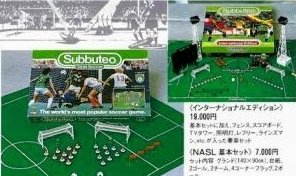
October 2023: Amazingly enough, another Japanese catalogue has surfaced in the collecting community, this one from 1984-85 judging from the "green box" accessory types illustrated. Once again, a small team range is shown, but here the box sets are equally reduced. The Japanese market was offered the two tier International Edition, and interestingly, the NASL version in place of a standard Club Edition (although in truth there is little difference). This does suggest that stock may have been coming from Jokari rather than Subbuteo in the UK. Either that, or Jokari had reduced their orders, and the extra sets had to go somewhere... Geographically, it perhaps makes sense to import from the US rather than Europe though.
The accessory range seems comprehensive, and the illustrations are lovely. It should be noted that C189 Skills Trainer is advertised here, but still in the monochrome box, whereas everything else has been updated. This ties to it still appearing as 61189 on the 1984 British poster, but that box never having been seen.
New Zealand - Thos Holdsworth & Sons Ltd.
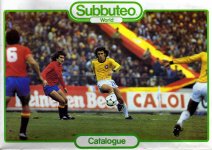
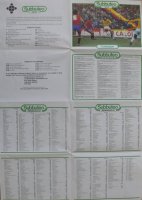
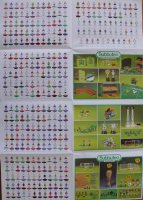
This catalogue was produced in New Zealand by Thos Holdsworth & Sons, and was simply the English catalogue from 1981 issued as a one piece fold-out item.
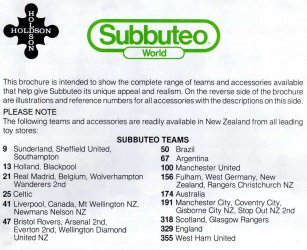
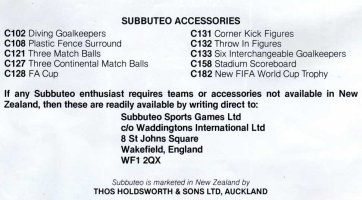
However, there are two additional pages added to explain which teams and accessories are actually available in New Zealand. Frustratingly for players of the period, the answer was "not many" - fifteen teams and ten accessories. Still you could at least buy a load of the all white reference 21, and then paint up some of the other 300 teams shown in the catalogue.
Pleasingly, a few New Zealand sides were added to the references that were sold. For instance, reference 47 was also Wellington Diamond Utd. They also provided the address of Waddingtons International if you wanted to import something not in the local range. This was in Wakefield, and was not the usual Leeds address.
Unlike the Japanese catalogue, Subbuteo rugby is not mentioned here. Judging from their relative strengths in the real sports, perhaps rugby and cricket would have been successful sellers for Subbuteo in this market, but these items were on their last legs by 1981.

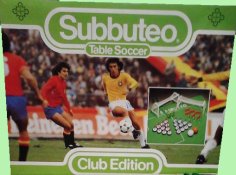
I've borrowed these pictures from the International box sets page, to show the slightly amended Club Edition that was actually sold by Theo Holdsworth. This looked like a standard UK club edition on the outside, with just the Holdson logos showing that it is anything different.
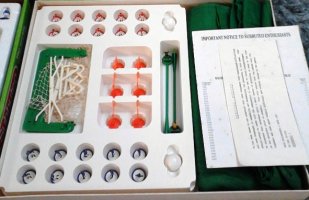
However, the inside had a unique design, with a practical plastic insert, that covered about two-thirds of the box. The other third gave amble room for the standard Subbuteo pitch. The players were housed upright (Hasbro repeated this trick fifteen years later). Tournament goals were provided. These were supplied flat-packed, and there was no room in the box to store them assembled. An extra note was included regarding assembling and disassembling the goals. The most quirky thing about the New Zealand set were the flags, which were produced completely in orange plastic - including the round bases. This is perhaps worth comparing with the "reversed colour" flags of the Pelebol set.